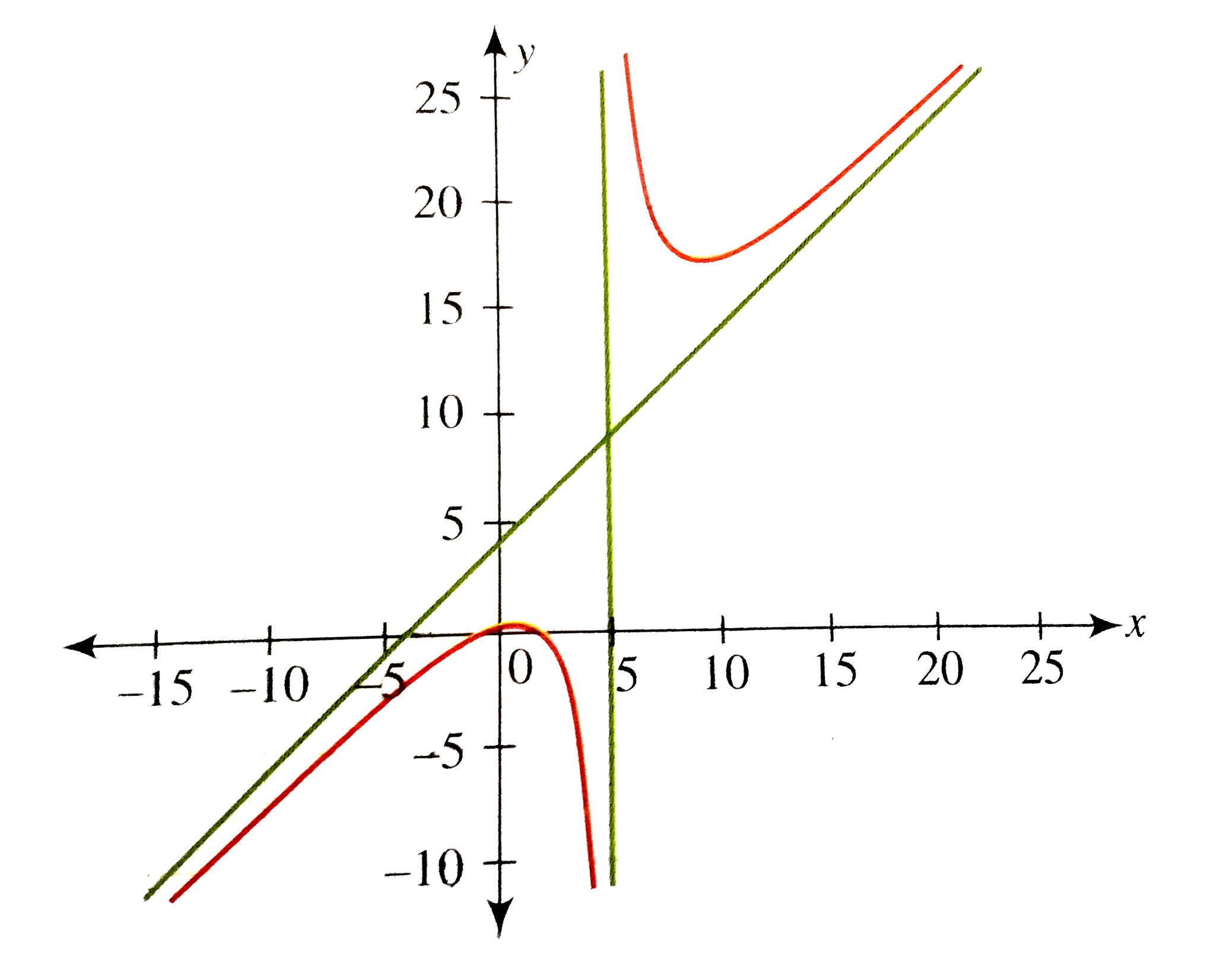Write a rational function f with a slant asymptote y=x+4, a vertical asymptote at x = 5 and one of the zeros at x = 2.Solution in Bengali
The graph of f has a slant asymptote y=x+4 and a vertical asymptote at x=5 , hence f(x) may be written as f(x)=(x+4)+a(x−5),
where a is a constant to be determined using the fact that f(2)=0 since f has a zero at x=2.
f(2)=(2+4)+a2−5=0∴a=18
Hence f(x) is given by f(x)=(x+4)+18x−5=x2−x−2x−5
Check the characteristics of the graph of f shown below.

Topper's Solved these Questions
- GRAPHS OF POLYNOMIAL AND RATIONAL FUNCTIONSBOOK - CENGAGE PUBLICATIONCHAPTER - GRAPHS OF POLYNOMIAL AND RATIONAL FUNCTIONSEXERCISE - Exercises
17 Videos
- GRAPHICAL TRANSFORMATIONSBOOK - CENGAGE PUBLICATIONCHAPTER - GRAPHICAL TRANSFORMATIONSEXERCISE - ILLUSTRATION
78 Videos
- GRAPHS OF ELEMENTARY FUNCTIONS BOOK - CENGAGE PUBLICATIONCHAPTER - GRAPHS OF ELEMENTARY FUNCTIONS EXERCISE - EXERCISES
34 Videos
Similar Questions
Draw the graph of y=(x−1)(x2−x+1).
View SolutionPlot y=|x|,y+x−2∣,andy=|x|2∣
View SolutionDraw the graph of y=1(1/x).
View SolutionIf length of perpendicular drawn from points of a curve to a straight line approaches zero along an infinite branch of the curve, the line is said to be an asymptote to the curve. For example , y-axis is an asymptote to y=lnx& x-axis is an asymptote to y=e−x.
If limx→0f(x)=e (a finite number) then y=e is an asymptote to y=f(x) . Similarly if limx→0f(x)=α, then y=α is also an asymptote.
If limx→af(x)=∞ or limx→af(x)=−∞, then x=a is a an asymptote to y=f(x).
Area bounded by y=2xx2+1, it's asymptote and ordinates at points of extremum is equal to (in suare unit)
View SolutionIf length of perpendicular drawn from points of a curve to a straight line approaches zero along an infinite branch of the curve, the line is said to be an asymptote to the curve. For example , y-axis is an asymptote to y=lnx& x-axis is an asymptote to y=e−x.
If limx→0f(x)=e (a finite number) then y=e is an asymptote to y=f(x) . Similarly if limx→0f(x)=α, then y=α is also an asymptote.
If limx→af(x)=∞ or limx→af(x)=−∞, then x=a is a an asymptote to y=f(x).
Area bounded by y=x2e−x and it's asymptote in first quadrant is equal to (in square unit)
View SolutionWrite a possible rational function h with a hole at x = 5, a vertical asymptote at x = -1, a horizontal asymptote at y = 2 and x-intercept at x = 2.
View SolutionWrite a rational function g with vertical asymptotes at x = 3 and x = -3, a horizontal asymptote at y = -4 and with no x-intercept.
View SolutionWrite a rational function f with a slant asymptote y=x+4, a vertical asymptote at x = 5 and one of the zeros at x = 2.
View SolutionWrite a possible rational function f that has a vertical asymptote at x = 2, a horizontal asymptote y = 3 and a zero at x = -5. Also draw the graph of the function.
View SolutionFind the slant (oblique) asymptote of the function f(x)=x2+3x+5x+2
View SolutionFind the asymptotes of the function f(x)=1x
View SolutionThe line x+y+1=0 is an asymptote of x2−y2+x−y−2=0. The other asymptote is
View SolutionWrite a rational function g with vertical asymptotes at x = 3 and x = -3, a horizontal asymptote at y = -4 and with no x-intercept.
View SolutionWrite a rational function f with a slant asymptote y=x+4, a vertical asymptote at x = 5 and one of the zeros at x = 2.
View SolutionWrite a possible rational function f that has a vertical asymptote at x = 2, a horizontal asymptote y = 3 and a zero at x = -5. Also draw the graph of the function.
View SolutionFind the slant asymptote of (x+3)(x+7)(x−5)
View Solution
